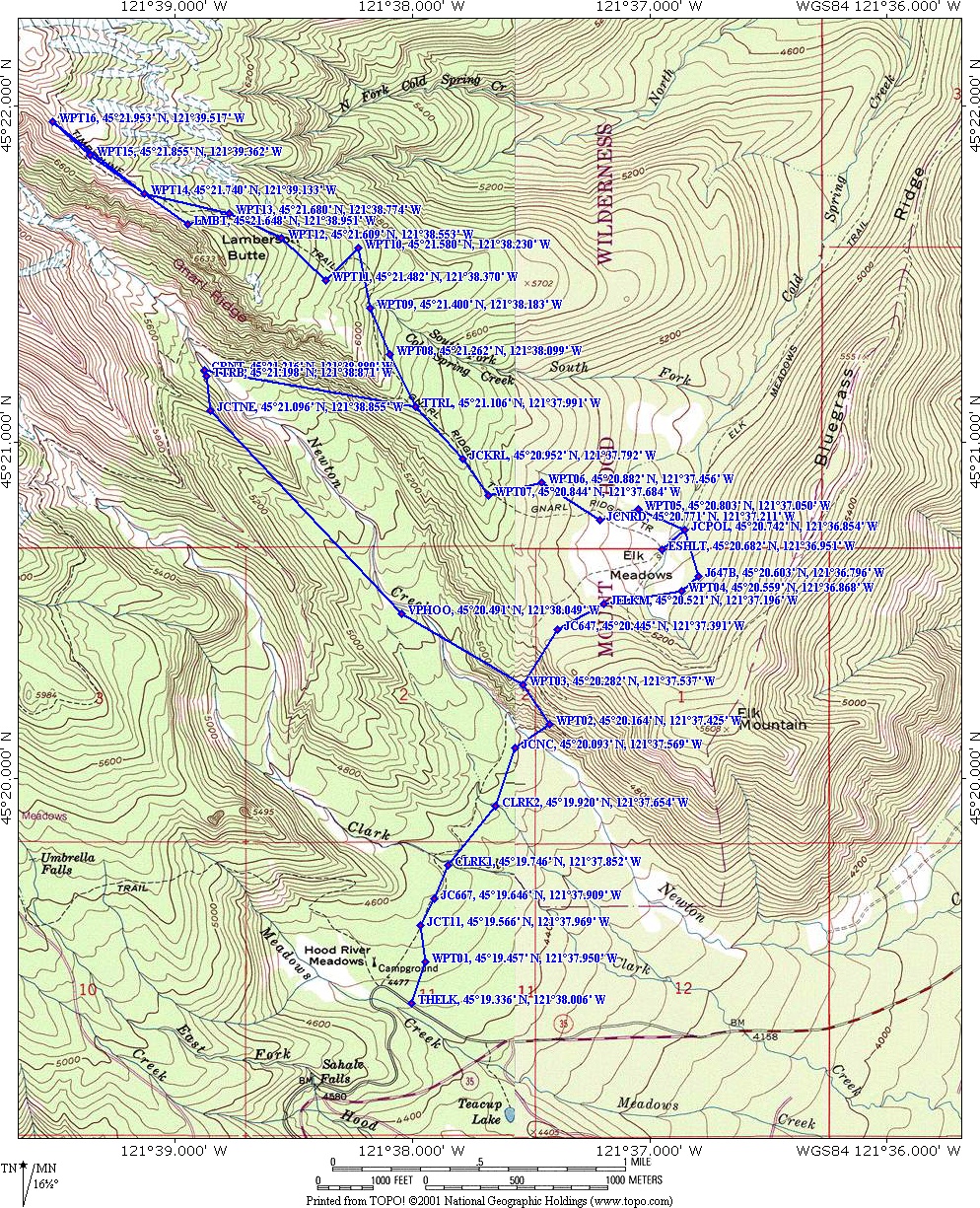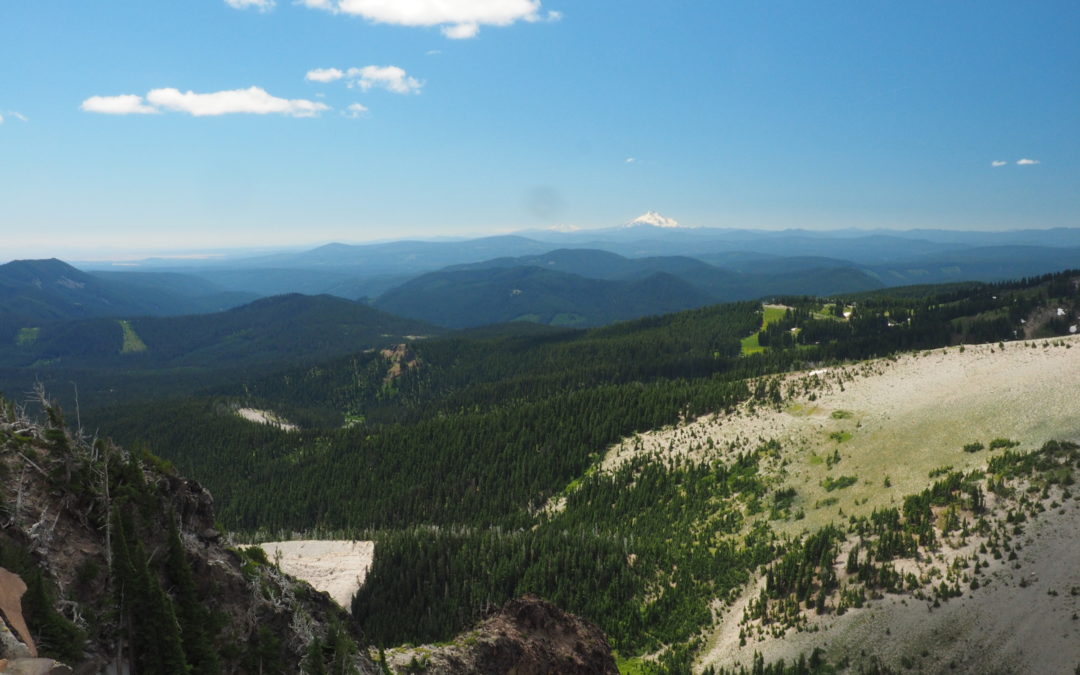Vicinity Location: The trailhead is about 49 miles southeast of Portland, Oregon in the Mt. Hood National Forest.
Directions: From Portland take I-84 East to the Wood Village, exit (16A). Head south and turn left onto NE Burnside Rd.
Heading East, Burnside will merge into Highway 26. Follow Hwy 26 past Government Camp and exit on Highway 35 to Hood River.
Follow Hwy 35 for 6.6 miles, drive under the highway overpass for Mt. Hood Meadows.
Drive about 1.2 miles past the overpass and turn left into the Mt. Hood Meadows parking area, for a total of 7.7 miles from the Highway 26 and 35 junction. Drive .3 mile to the trailhead which is along the road.
Seasonally there are outhouses at the trailhead.
The parking area is large enough to accommodate a lot of cars.
A Northwest Forest Park permit is required at the trailhead.
Length and Elevation:
11.5 miles round trip. Elevation at the trailhead is 4,450 feet. Elevation gain is about 820 feet and the loss is 210 feet to the shelter at Elk Meadows. Total gain is 2,736 and loss is 242 feet. Total gain and loss is 4,975 feet. Elevation of Lamberson Butte is 6,633 feet. High point is about& 6,950 feet.
Trail: Elk Meadows Trail #645, Gnarl Ridge Tie Trail #652A, Gnarl Ridge Trail #652, Timberline Trail #600, Newton Creek Trail #646. Connections to Umbrella Falls Trail #667, Bluegrass Ridge Trail #647, Bluegrass Ridge Tie Trail #647B
There are no known geocaches along this trail at the time of this review.
Trail Maps: National Forest Service Map, Topo Map, Download Garmin .gpx file
Review: August 21, 2010, July 22, 2017
This trail becomes dusty during dry periods because of the fine volcanic soil. The first mile of this trail is relatively flat as you make your way towards Newton Creek. At .4 mile from the trailhead is a trail junction for Umbrella Falls. Continue straight ahead and cross Clark Creek on a large log bridge.
The trail next crosses a few small creeks, and continue straight at the junction of Newton Creek Trail. The bridge across Newton Creek washed out several years ago but there is usually a makeshift bridge across the creek. At the time of this review there are a few small logs to cross on. The bridge is just above the creek so any flooding will wash away the bridge.
Once across Newton Creek, find where the trail enters the woods again and the tread becomes covered in a thin layer of forest debris which eliminates the dust. The trail immediately starts switchbacking up the ridge on the north side of the creek.
The switchbacks don’t last very long and you reach the plateau, walk through the forest for a bit and 1.75 miles from the trailhead you come to a 4-way junction with the Bluegrass Ridge Trail, #647 that goes towards Elk Mountain and the Gnarl Ridge Trail on the left. Continue straight ahead and continue to Elk Meadows.
At 1.9 miles is the trail junction for the Elk Meadows Perimeter Trail. #645. Turn right towards Pollallie Campground and follow the perimeter trail towards Elk Meadows. Following around the edge of the meadows you come to Bluegrass Ridge Tie Trail #647B at 2.4 miles from the trailhead. Turn left here and continue following the mostly level trail around Elk Meadows.
Elk Meadows is marshy along the edges where the mosquitoes like to breed but it also affords great views of Mt. Hood. At just over 2.5 miles is a trail junction to Polallie Campground, waypoint JVPOL. Turn left at this trail junction, heading back into Elk Meadows along a small stream.
The next junction is for the Elk Meadows Shelter. Go straight and walk about .1 mile, over a stream, and reach the shelter. The shelter is a wooden structure covered in cedar shakes. The 3-sided adirondak is slowly falling apart. You can see the nails pulling out of the roof and the shakes coming off the sides. The roof is mostly waterproof and there is a dirt floor with a fire pit out front. The best time to see the lupines flowering at Elk Meadows would be in July. The nearby meadows contain masses of lupines and look spectacular in full bloom.
Walk back to the trail junction and make a left to continue walking around the perimeter of Elk Meadows. As you cross the stream again there one more small campsite. The trail continues to skirt the meadow in the woods. Walking through the woods for the next .3 mile, look for underground streams along the trail. Looking into the holes you can see the water flowing down in the ground. Be careful not to step into one of them.
At 3.1 miles from the trailhead is the junction for the Gnarl Ridge Trail #652 and the continuation of the Elk Meadows Perimeter trail. Turn right and take the trail up Knal Ridge. The trail climbs fairly gently at first from Elk Meadows, then more steeply as you come onto the ridge.
At 3.5 miles from the trailhead there are some glimpses of Mt. Hood through the trees. Then in another .2 mile is the junction with the Gnarl Ridge Trail. From here you continue uphill on the trail through the volcanic soil. There still are no rocks in the trail but you can tell from the vegetation that the soil dries out quickly and doesn’t support nearly as much undergrowth as along Elk Meadows. The trees here are mainly Hemlock and Silver Fir.
Where the Gnarl Ridge trail ends at the junction with the Timberline Trail, turn right and head up the dusty trail towards Cloud Cap. Once you are on the Timberline Trail the forest opens up more as you gain elevation because the trees can’t survive the harsh winters. The lupine is changing too. It isn’t as tall as the lupine in Elk Meadows and it blooms later because of the altitude.
The Timberline Trail lazily switchbacks up through open, shady forests and small open meadows with Lupines as the trail climbs along the side of Lamberson Butte. If you take the trail early in the morning you will see deer and elk tracks from the previous night. At about 4.9 miles the trail comes out of the woods to nice views to the east of Mt. Adams and you can see where the Gnarl Ridge fire burned in 2008.
Also you can see the dry plains of the Columbia Plateau. In a short distance a better view of Mt. Hood appears. After about 5.25 miles only dwarf trees or krumholtz can grow and you come out on a rocky ridge overlooking Newton Creek. From here you have unobstructed views of Mt. Hood and Mt. Jefferson.
When the trail comes out of the trees and comes out onto a sandy ridge and you can see a deep canyon off to your left then Lamberson Butte is just behind you on your left. Lamberson Butte is the point of rock behind you.
You can climb partway up Lamberson Butte and there is a nice place to sit and enjoy the panoramic views and the sounds of Newton Creek rushing through the valley below. You could climb up farther to the top of the butte for views of Mt. Adams and Mt. Rainier.
If you would like to see a small waterfall you continue up the trail another .25 mile to some snowfields or hike up to Cloud Cap, another few miles away.
On the way back down, enjoy the panoramic views into Eastern Oregon as Mt. Hood becomes obscured by the trees. You’ll find it is much easier hiking down the trail then up. The trail soon becomes less rocky and easier to navigate.
If you’re not bringing a dog, bear right at the junction of the Gnarl Ridge Trail and the Timberline Trail and continue down the Timberline Trail. If you have a dog it is highly recommended that you follow the Gnarl Ridge Trail all the way down to Elk Meadows Trail, then turn right and retrace your way back to the trailhead.
If you choose to continue down the Timberline Trail then be sure to look up from the trail to see Mt. Hood rising above you. In the distance you can hear the waters of Newton Creek.
The trail passes underneath a rocky outcrop as you continue walking towards Mt. Hood. As you approach Newton Creek, the trail climbs about 50 feet up to the streambed. From the floodplain you are treated to wildflowers and a great view of Mt. Hood.
Follow the rock cairns to the stream crossing and once across the stream you have to use your hands to pull yourself up the steep bank on the far side. There is no way to carry a pet up or down this slope at this point of the trail. The trail picks back up on the far side of Newton Creek, a little downstream from where you cross Newton Creek. There are usually some logs to cross over Newton Creek but any high water will easily wash them away. Newton Creek is very dangerous to cross in times of high water.
From the crossing, the trail heads uphill past a lovely spring. The spring is just a couple of hundred feet away from Newton Creek. The water almost gushes out of the ground and is a great place to fill up on water without needing to filter the water.
Once across Newton Creek and past the spring the trail climbs up a couple switchbacks and meets the junction for the Newton Creek Trail #646. Go left here, leaving the Timberline Trail and follow the trail down to the Elk Meadows Trail. Look back for the last glimpses of Mt. Hood.
The trail follows a lateral moraine along Newton Creek. Lateral moraines are from when the glaciers that were once here deposited dirt and rocks along the edge of the glacier as the glacier flowed down the valley. Parts of this moraine are eroding into Newton Creek and in a couple of places the trail is about to be eroded by Newton Creek so take some care crossing these exposed area. There are a few more viewpoint of Mt. Hood back through the trees.
Traveling along the Newton Creek Trail the dry moraine soil suddenly changes to forested terrain. From here the trail descends a little more gently and the sounds of Newton Creek return. Small sections of this trail have been rebuilt after Newton Creek has washed away the trail and continues to undercut the bank in places. It is only a matter of time before more portions of the trail wash away. Be very cautious in these sections because the bank is unstable from the creek undercutting the bank.
Make sure children and pets stay away from the edge lest they get too close and the edge breaks off and plunges them 15 feet to the streambed below.
After walking along the trail, turn right at the Elk Meadow trail and walk on the fairly level trail back to the trailhead. The hard work is all done and you can enjoy your walk back over Clark Creek and back to the car.
The trail is well maintained and most all the deadfall has been cleared off the trail and there isn’t much brush along the trail.
Elk Meadows and the Gnarl Ridge Trail are fine for children and pets, as long as there is a log crossing over Newton Creek. The Newton Creek Trail has hazardous places for Children and pets.
Enjoy the photos!
Gallery Pics
Switchback Steve




Recent Comments